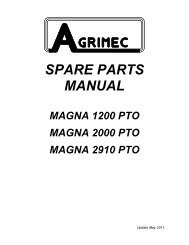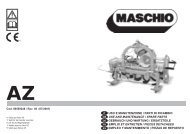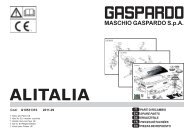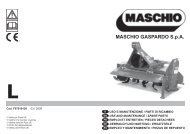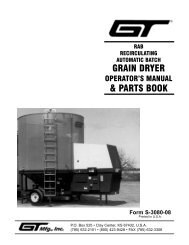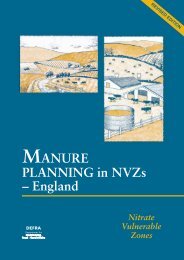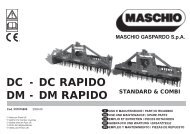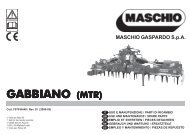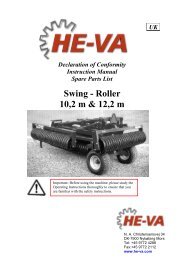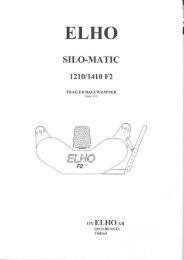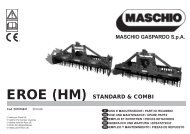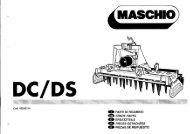GIRAFFETTA OK15.pmd - Opico
GIRAFFETTA OK15.pmd - Opico
GIRAFFETTA OK15.pmd - Opico
Create successful ePaper yourself
Turn your PDF publications into a flip-book with our unique Google optimized e-Paper software.
ITALIANO ENGLISH FRANÇAIS DEUTSCH<br />
ESPAÑOL<br />
Intasamento del rotore<br />
- Terreno troppo bagnato per lavorare.<br />
- Sollevare la macchina dal terreno.<br />
- Ridurre la velocità d'avanzamento.<br />
- Evitare di lavorare con presenza di<br />
erba molto alta, eventualmente pulire<br />
bene ai lati del rotore ciò che si è fermato<br />
sui supporti per evitare<br />
surriscaldamenti eccessivi.<br />
Ingolfamento del vano rotore<br />
- Terreno troppo bagnato. Erba molto<br />
alta.<br />
- Arrestare il motore.<br />
- Accertarsi che tutte le parti in movimento<br />
siano ferme.<br />
- Pulire accuratamente con adeguate<br />
attrezzature il vano rotore da tutto ciò<br />
che si è accumulato.<br />
La macchina rimbalza sul terreno<br />
o vibra<br />
- Corpi estranei bloccati fra i coltelli.<br />
- Coltelli montati non correttamente senza<br />
la disposizione elicoidale o con il<br />
bordo che penetra nel terreno.<br />
- Coltelli consumati o rotti.<br />
- Deformazione del rotore dovuta a colpi<br />
ricevuti nella parte centrale, durante<br />
il lavoro da corpi estranei.<br />
Altri inconvenienti<br />
La macchina non lavora allo stesso modo<br />
su tutta la larghezza. Ad esempio, sminuzza<br />
troppo sul lato destro.<br />
Accorciare il braccio destro.<br />
Lavoro in collina<br />
Se possibile procedere «salendo» nel<br />
senso della pendenza. Se non è possibile<br />
evitare di lavorare lungo i fianchi della<br />
collina, effettuare i passaggi dall'alto verso<br />
il basso per ridurre l'effetto terrazza.<br />
Osservazioni pratiche<br />
Il terreno lavorato dovrebbe trovarsi sempre<br />
alla destra del guidatore. Il sistema<br />
migliore è di lavorare a striscie alternate.<br />
Clogging of the rotor<br />
- Ground too wet to work.<br />
- Raise the machine from the ground.<br />
- Reduce forward speed.<br />
- Avoid working in presence of very tall<br />
grass. Eventually clean away what has<br />
collected on sides of rotor in order to<br />
prevent excessive overheating.<br />
Clogging in the rotor compartment<br />
- Soil too wet. Very tall grass.<br />
- Stop the engine.<br />
- Make sure that all moving parts are at<br />
a standstill.<br />
- Thoroughly clean all the accumulated<br />
material from the rotor compartment<br />
with an adequate tool.<br />
The machine bounces on the<br />
ground, or vibrates<br />
- Foreign bodies are caught in the<br />
blades.<br />
- Blades mounted incorrectly, without the<br />
helicoidal arrangement, or with the<br />
edge penetrating into the ground.<br />
- Blades worn or broken.<br />
- Deformation of the rotor due to blows<br />
received from foreign bodies in the<br />
central part, during work.<br />
Other inconveniences<br />
The machine does not work in the same<br />
way along all its width, e.g. it shreds more<br />
on the right side. Shorten the right arm.<br />
Working on hills<br />
When possible, proceed by moving upwards<br />
in the direction of the slope.<br />
If it is not possible to avoid working along<br />
the sides of the hill, work from top to bottom<br />
to reduce the terracing effect.<br />
Practical hints<br />
The worked ground must always be on<br />
the right of the driver. The best system is<br />
to work in alternating strips.<br />
Engorgement du rotor<br />
- Terrain trop mouillé pour travailler.<br />
- Soulever le machine du terrain.<br />
- Réduire la vitesse d’avancement.<br />
- Eviter de travailler en présence d’herbe<br />
trop haute, enlever éventuellement les<br />
déchets qui se sont déposés sur les<br />
supports de chaque côté du rotor pour<br />
éviter une surchauffe excessive.<br />
Bourrage du compartiment rotor<br />
- Sol trop mouillé. Herbe trop haute.<br />
- Stopper le moteur.<br />
- S’assurer que toutes les parties en<br />
mouvement sont arrêtées.<br />
- Nettoyer soigneusement avec des<br />
équipements appropriés le compartiment<br />
rotor de tout ce qui s’est accumulé.<br />
Le machine rebondit sur le terrain<br />
ou vibre<br />
- Corps étrangers bloqués entre les lames.<br />
- Lames montées de façon incorrecte<br />
sans la disposition hélicoïdale ou avec<br />
le bord qui pénètre dans le terrain.<br />
- Lames usées ou cassées.<br />
- Déformation du rotor due à des coups<br />
donnés dans la partie centrale par des<br />
corps étrangers durant le travail.<br />
Autres inconvénients<br />
Le machine ne travaille pas de la même<br />
façon sur toute la largeur. Par exemple,<br />
il émiette trop du côté droit.<br />
Raccourcir le bras droit.<br />
Travail en colline<br />
Si possible, travailler «en montant» dans<br />
le sens de la pente.<br />
Sinon, éviter de travailler le long des<br />
flancs de la colline, effectuer les passages<br />
du haut vers le bas pour réduire l’effet<br />
terrasse.<br />
Observations pratiques<br />
Le terrain travaillé devrait toujours se<br />
trouver à la droite du conducteur.<br />
Le meilleur système est de travailler à<br />
bandes alternées.<br />
Verschmutzung des Rotors<br />
- Zu nasse Bodenverhältnisse.<br />
- Die Maschine leicht anheben.<br />
- Die Fahrgeschwindigkeit vermindern.<br />
- Nicht bei zu hohem Graswuchs arbeiten;<br />
die Seiten des Rotors von möglichen<br />
Ablagerungen gut reinigen, um<br />
eine Überhitzung zu vermeiden.<br />
Verstopfung des Rotorraums<br />
- Boden zu nass. Gras zu hoch. Ahogado del compartimiento<br />
- Den Motor anhalten.<br />
rotor<br />
- Sicherstellen, dass alle beweglichen<br />
Teile still stehen.<br />
- Den Rotorraum mit dazu passender<br />
Vorrichtung sorgfältig reinigen und alles,<br />
was sich darin angesammelt hat,<br />
- Terreno demasiado mojado. Vegetación<br />
demasiado alta.<br />
- Parar el motor.<br />
- Cerciorarse que todas las partes en<br />
movimiento estén paradas.<br />
entfernen.<br />
- Quitar escrupulosamente con<br />
equipamientos adecuados todo lo que<br />
se haya acumulado en el compartimiento<br />
rotor.<br />
Die Maschine arbeitet ruckartig<br />
oder vibriert<br />
- Fremdkörper sind zwischen den Messern<br />
blockiert.<br />
- Falsch montierte Messer - entweder<br />
ohne schraubenförmige.<br />
- Falsch montierte Messer - entweder<br />
ohne schraubenförmige Anordnung,<br />
oder so montiert, daß die Messer in<br />
den Boden greifen.<br />
- Abgenutzte oder schadhafte Messer.<br />
- Verformung des Rotors aufgrund von<br />
Schlägen (eventuell durch Fremdkörper)<br />
an dessen Mitte.<br />
Weitere Störungen und Probleme<br />
Die Maschine arbeitet nicht gleichmäßig<br />
über die gesamte Breite. Sie zerkleinert<br />
z.B. mehr auf der rechten Seite. Den<br />
rechten Ausleger verkürzen.<br />
Arbeiten auf hügeligem Boden<br />
Falls möglich, sollte «ansteigend» gearbeitet<br />
werden. Kann ein Arbeiten entlang<br />
der Seiten eines Hügels nicht vermieden<br />
werden, so empfiehlt sich ein Arbeiten<br />
von oben nach unten, um den Terrasseneffekt<br />
so weit als möglich zu vermeiden.<br />
Atascamiento del rotor<br />
- Terreno muy mojado para trabajar.<br />
- Levante la máquina del terreno.<br />
- Reduzca la velocidad de avance.<br />
- No trabaje con hierbas muy altas,<br />
eventualmente, limpie perfectamente<br />
de los costados del rotor lo que se acumuló<br />
sobre los soportes, para evitar<br />
sobrecalentamientos excesivos.<br />
El triturador salta sobre el terreno<br />
o vibra<br />
- Hay cuerpos extraños bloqueados entre<br />
las cuchillas.<br />
- Las cuchillas no han sido instaladas<br />
correctamente, sin la disposición<br />
helicoidal o con el borde que penetra<br />
en el terreno.<br />
- Las cuchillas están desgastadas o rotas.<br />
- El rotor está deformado a causa de<br />
golpes que ha recibido en la parte central<br />
durante el trabajo, producidos por<br />
cuerpos extraños.<br />
Otros incovenientes<br />
El triturador no trabaja de la misma manera<br />
en todo el ancho.<br />
Por ejemplo, tritura demasiado en la parte<br />
derecha. Acorte el brazo derecho.<br />
Trabajo en colinas<br />
Si es posible, «suba» en el sentido de la<br />
pendiente. Si no es posible evitar trabajar<br />
a lo largo de las laderas de la colina,<br />
efectúe pasajes desde arriba hacia abajo<br />
para reducir el efecto terraza.<br />
Praktisches<br />
Observaciones prácticas<br />
Die zu bearbeitende Fläche sollte sich El terreno elaborado siempre tiene que<br />
stets auf der rechten Seite des Lenkers estar a la derecha del conductor. El mejor<br />
sistema es el de trabajar por hileras<br />
befinden. Am geeignetsten ist ein Arbeitsvorgang<br />
in abwechselnden Streifen. alternadas.<br />
43



